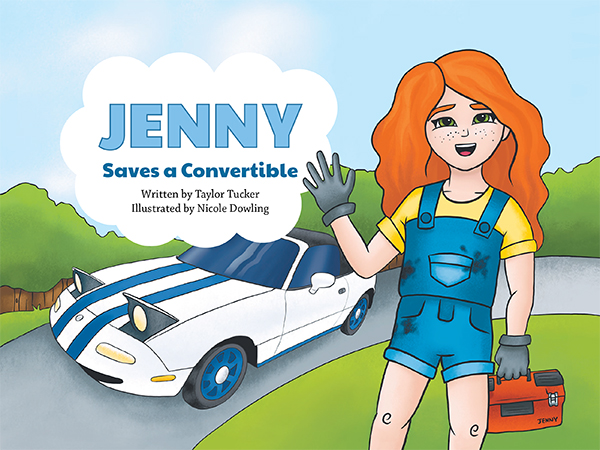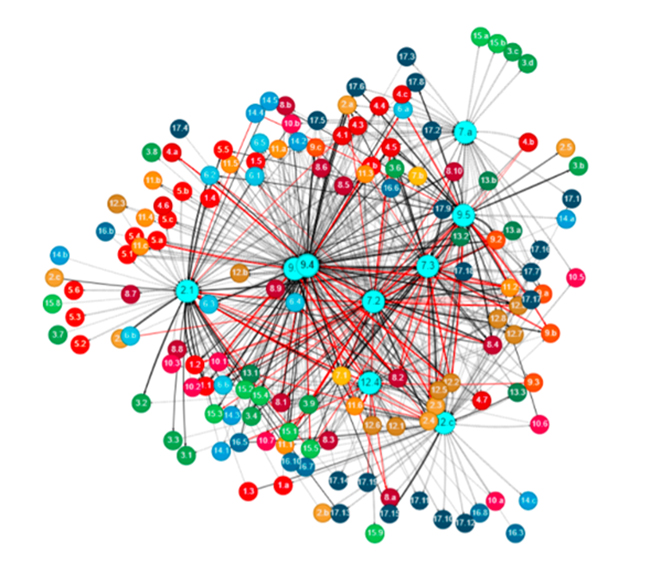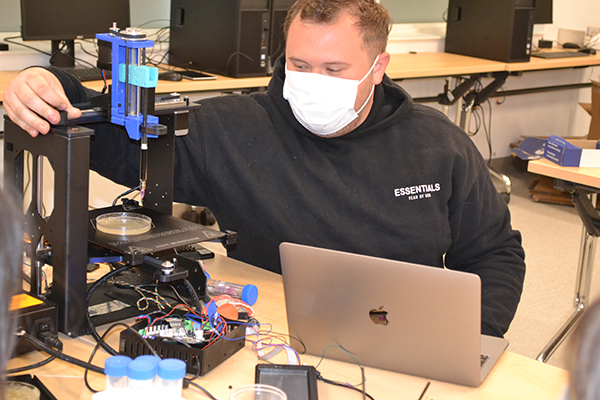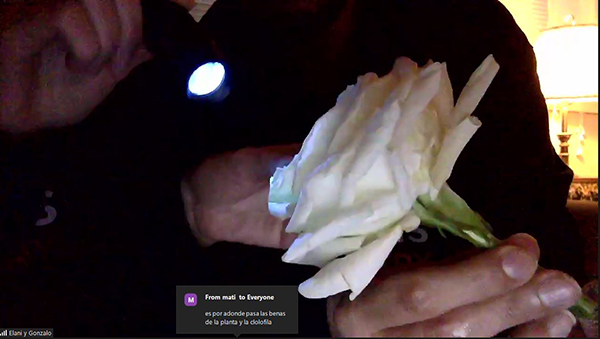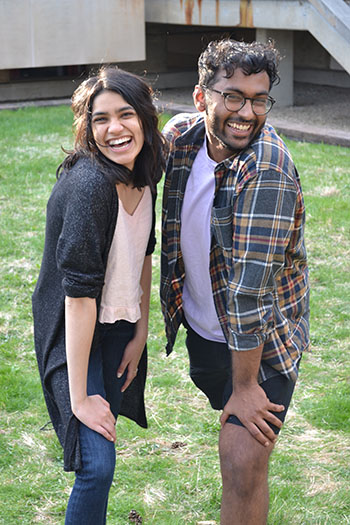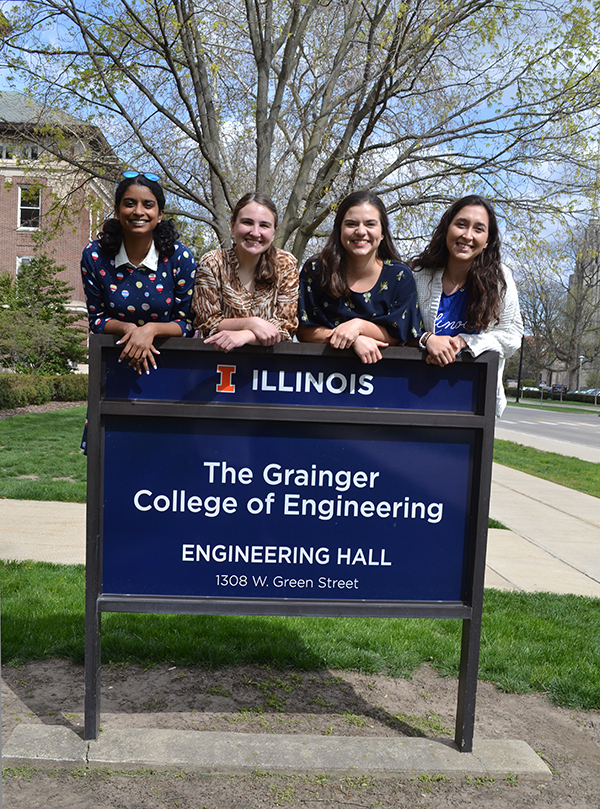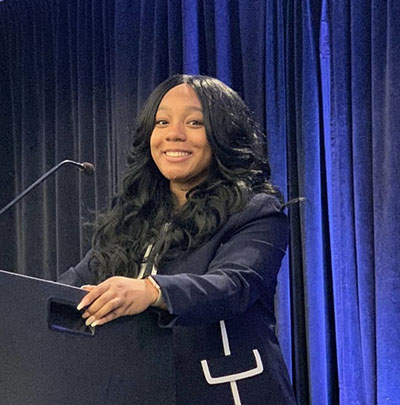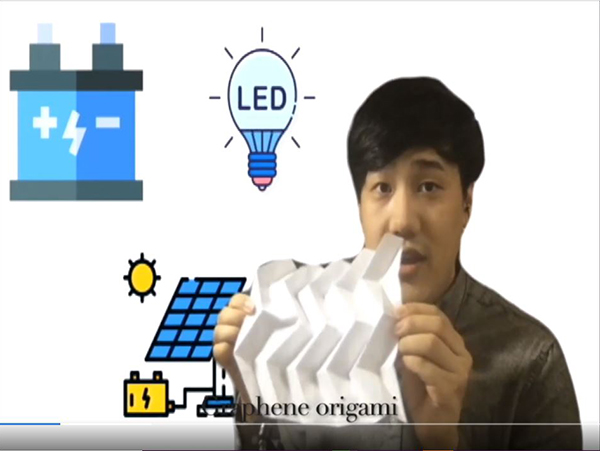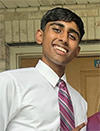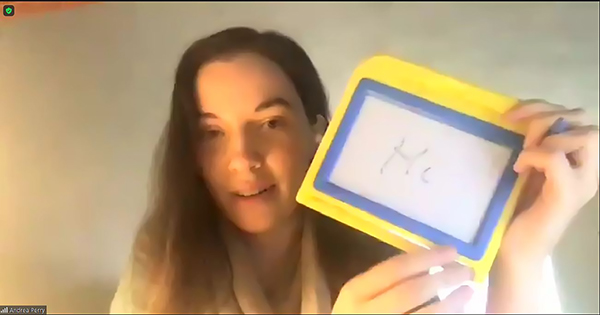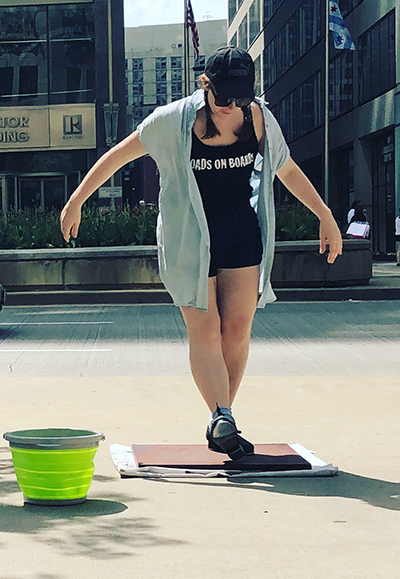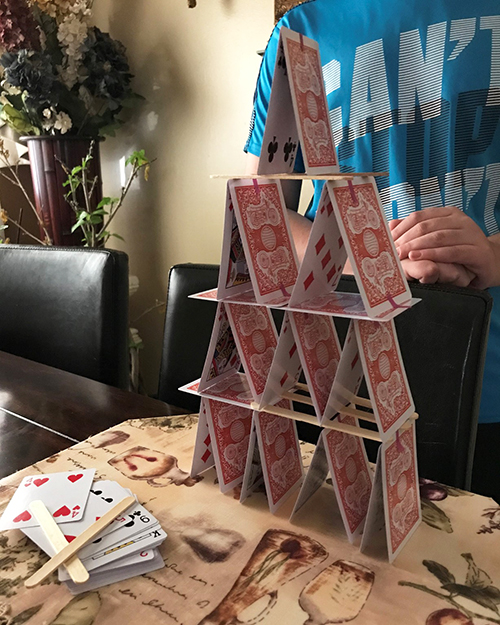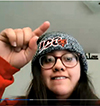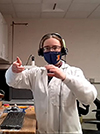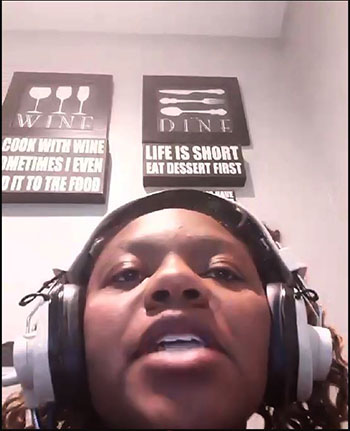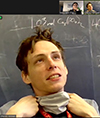MechSE Grads Milner & Armstrong Trade in Sports Outreach for STEM Via ENVISION
May 20, 2016
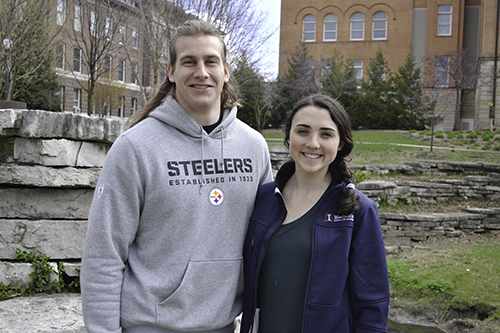
MechSE grad students Matt Milner and Ashley Armstrong, creators of the ENVISION MechSE grad student outreach group.
Mechanical Science and Engineering (MechSE) graduate students Matt Milner and Ashley Armstrong were both student athletes while getting their undergrad degrees in STEM. And they both cut their teeth on athletics outreach—but back then, they did sports camps, not STEM camps. So when they arrived at Illinois to continue their education, both were sensing an outreach-shaped vacuum in their lives and felt it was important that they share their passion about STEM. But since there didn’t appear to be a vehicle through which they could do STEM outreach, they decided to build one—called ENVISION.
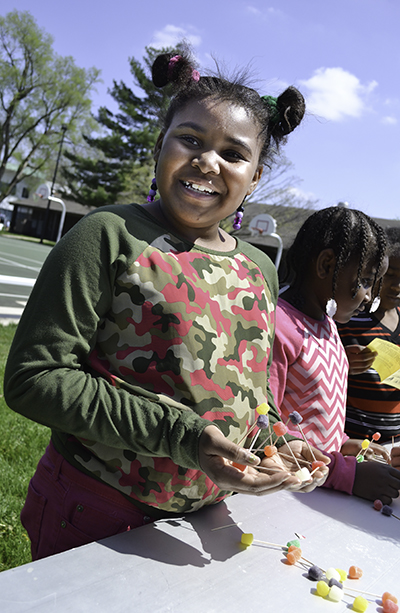
A BTW student exhibits her gumdrop/toothpick structure during the Booker T. Washington Family Engineering Fair that Miler and Armstrong helped to organize.
Both Milner and Armstrong were fairly unique among their fellow undergraduate athletes, in that they were both enrolled in difficult programs of study. Even more unique—both excelled at academics as well as sports. While getting a degree in Mechanical Engineering at University of Notre Dame, Armstrong played women's golf and was an Academic All-American—twice. Milner, who played football at East Carolina was also a two-time Academic All-American—while studying Physics.
Once they arrived at Illinois, they actually got to know each other at a rather serendipitous encounter while working up a sweat at a local gym. They each noticed that the other looked familiar, asked, “Hey, aren’t you a part of Mechanical Engineering?’ and immediately bonded over their love of engineering and athletics. “We’ve been friends since,” says Milner. That’s when they also learned of their mutual interest in outreach, and each acknowledged that they were missing it.
“I think in the transition from student athlete life to grad student life,” acknowledges Armstrong, “we both realized that there was a big gap of no outreach. We decided to kind of address that issue.”
“Because we did outreach in a different manner during our undergrad, through athletics,” adds Milner. “Ok, we’ve shifted. We’ve set aside our sports gear, and now we’re looking at, ‘Ok, how do we do outreach with this new role? How do we involve all kids, bring them into engineering and STEM education in general?...So we actually started up a group—ENVISION: ENgineers Volunteering In STEM EducatION,” explains Milner.
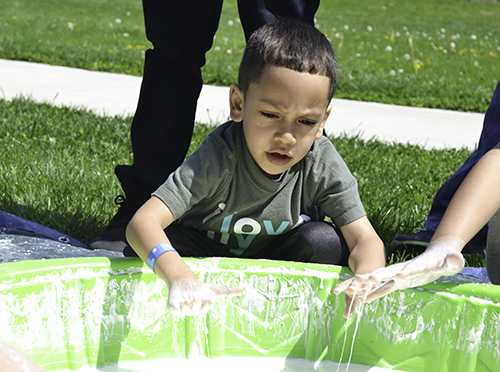
A young visitor to the Fair enjoys the Oobleck Pool.
After firming up their plans during the fall 2015 semester and over winter break, the two officially began ENVISION in the Spring 2016 semester. The grad student organization currently has around eight or nine MechSE students, but depending on how the prototype works out, they’re thinking about possibly opening it up to graduate students from the entire College of Engineering.
Their goal: to “provide an outlet and some way to get to know people who want to do something in the community as well,” explains Armstrong.
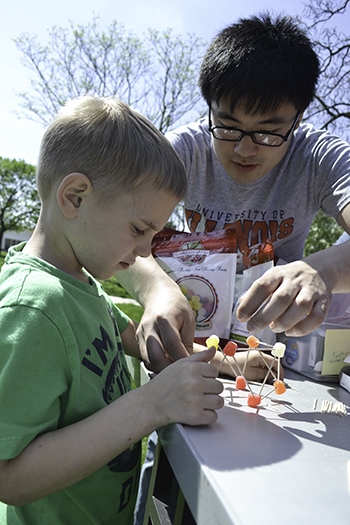
A young visitor to the Fair gets a little help on his gum drop-toothpick dome.
Armstrong reports that last semester, she did an outreach program that not many people knew about.
“I realized that I had had to dig kind of deep and find these outreach programs,” she indicates. “So the goal with ENVISION is to make it very accessible.” Their goal isn’t to “beat out other groups that are currently providing outreach opportunities, but maybe make a calendar of events so that people can go to our website, ‘Oh, this group is doing this outreach event.' So just to make outreach more accessible in general,” explains Armstrong.
One of their strategies that they believe is unique among the different outreach groups? They emailed MechSE professors this past semester to let them know that ENVISION is available: “We are a resource for them,” says Armstrong, “so if they want to try out any outreach for grants, if they need people to try out ideas…We’ve actually had professors reach out to us this semester so far.”
Their target audience: elementary and middle school students. “We want to show them that it’s cool,” says Milner, then admits. “I probably got made fun of for studying physics in undergrad football, but I stuck to it, and they probably didn’t have any idea what I was talking about.”
Was he the only physicist on the football team? “Yea, yea,” he admits. “But it’s not a bad thing to have an interest in and have a love for science.”
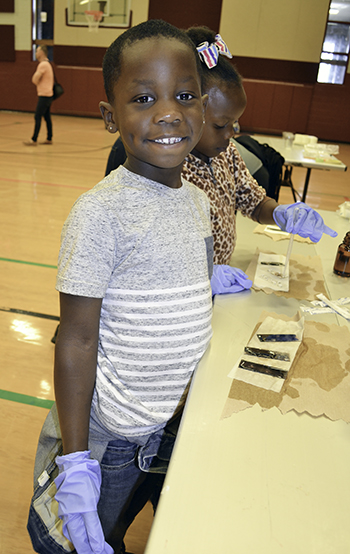
A BTW student proudly displays the mirrors he made in preparation for making a kaleidoscope.
Was he able to apply physics while playing football? Evidently he’d been asked that question before:
“During my undergrad, I gave an interview, and they asked, ‘How does physics relate to football?’ According to Milner, football is replete with examples of physics. Such as throwing the football, or something he did on his end of the field: “Anything. Like momentum,” cites Milner, giving a concrete example he evidently had put to good use when blocking opponents as a defensive end at East Carolina. “In order to have the most momentum, I want to have the most mass, and I want to be the fastest, and I want to have the most velocity in order to punish that opponent!”
Armstrong adds that they have strategies for reaching out to both girls and boys: “Make it seem like it’s cool, especially for young boys. Also we want to get girls involved to show them that it’s a really good avenue, and there are girls. It’s not just old science men in labs conducting weird experiments.”
And that works out, because out of the people who’ve participated, they’ve had both guys and girls—about 50/50.
The fledgling group has participated in five outreaches so far: a 3D printing activity at King Elementary; a LEGO Robotics MindStorm activity at the Champaign Public Library with Edison Middle School students; Science Night at King Elementary, and Science Night at Leal Elementary.
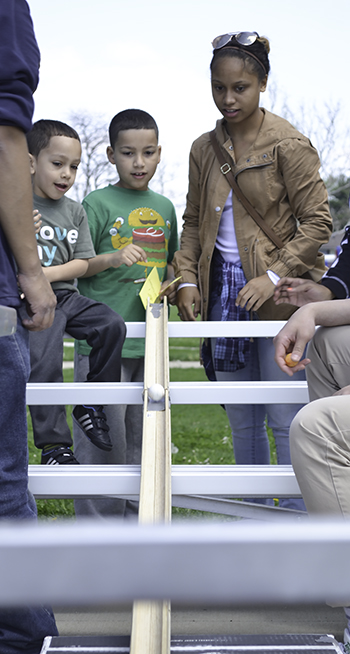
A BTW family watches to see if their ball hits the targeted receptacle on the Ball Run activity. (Photo courtesy of Jeremy Innes.)
Plus a fifth activity in which Milner and Armstrong had a significant role: a Family Engineering Fair at Booker T. Washington (BTW) STEM Academy on April 23rd. Milner and Armstrong were responsible for planning all of the events for the outreach, as well as helping to recruit volunteers from Illinois. For example, they came up with a number of smaller activities that could be done by a small group of kids or a family. “The idea of these is not to be very overwhelming, just do something that’s quick and fun; to just teach a very simple, basic science concept,” explains Armstrong. These activities were:
- Ball Run
- Egg Carton Battery
- Elephant Toothpaste
- Gum Drop/Toothpick Domes
- Oobleck Wading Pool
- Silly Putty
- Wind Turbines
There were also some larger events that would take a bit longer, for which folks would need a ticket for a certain time; the first two of these, the students would get to take home as souvenirs:
- 3D Printing, Lithography,
- A Kaleidescope, which involved silvering mirrors
- Stomp Rockets
- Fog Ring Cannons
They also recruited volunteers from two undergrad Mechanical Engineering student groups: Pi Tau Sigma and ASME (American Society of Mechanical Engineers).
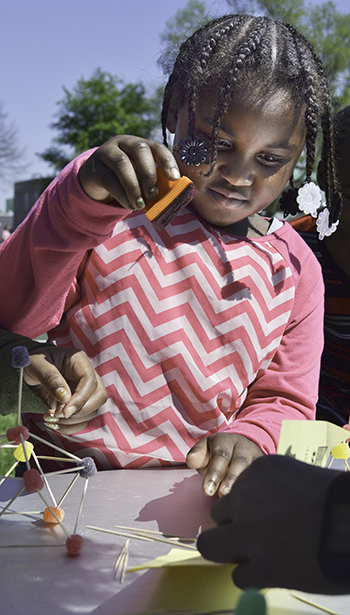
A BTW student stamps her passport after having completed her gumdrop/toothpick structure.
Also, taking a page from Disney World, they had a passport students could have stamped after they completed each activity. To give students an incentive to go to as many events as possible, students who went to a certain number of activities received a gift card, such as Jimmy John’s.
In addition to the different University groups, the event also had a couple of community partners: the Douglass Branch Library and the Champaign Park District, along with BTW’s PTA group.
“I think it’s good to also bring people in the community together,” says Miler regarding the different partners for the event, “but also utilize all these different avenues that we have.” Some of the bigger events were held in the basement of the Douglass Branch Library, to get folks familiar with the resource.
Milner and Armstrong hope the Engineering Fair piqued the students’ interest in STEM: “I hope that it showed them how cool science and math and STEM in general can be," admits Milner. "And that it’s something to pursue. It’s something to go after. You build in them a drive and a desire to want to pursue this further. Give them that curiosity and let that curiosity work its magic in them and lead them to science and math and engineering.”
Another impact the two hope the Fair had was to show kids that science and engineering are team sports:
“I also think a lot of kids—I know I kind of thought this growing up—they think that science is very individual, and at that age you want to be with your friends. You want to be involved with as many friends as possible. So this kind of fair is very interactive, and so it shows that in science, you have to do it in a group. It’s not an individual venture.”
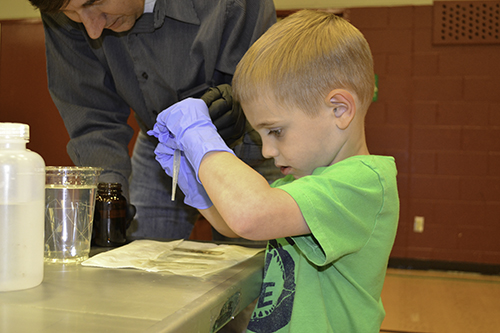
A young visitor to the Fair is silvering some mirrors for his kaleidoscope.
The event's planners, including Milner and Armstrong, BTW principal Ryan Cowell, and MechSE Education Coordinator Joe Muskin, dream that in the future, the Fair would become a large community event: “It would be hosted by Booker T. Washington, but other people could come,” Armstrong envisions. “Because we mentioned a lot of activities, but if you saw the size of this field, we could have put a lot more. So hopefully, in the future, it grows into a huge event. It would be cool to make it like an engineering fair.”
As if seeing in his mind’s eye the large crowd of community folk to prepare for in the future, Milner makes one last stab at recruiting: “We’re always looking for volunteers,” he claims. “We’re always looking for any help.”
Story and photographs by Elizabeth Innes, Communications Specialist, I-STEM Education Initiative.
For more related stories, see: K-6 Outreach, 6-8 Outreach, BTW STEM Academy, Grad, MechSE, 2016
For another istem article about BTW's 2016 Family Engineering Fair, see:
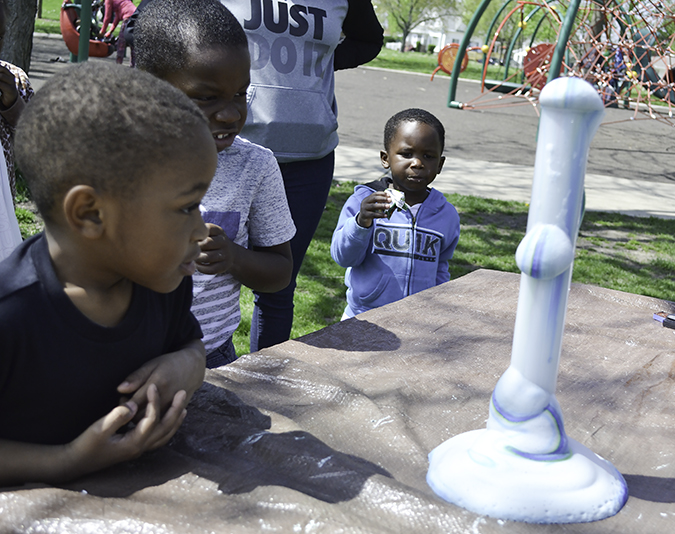
Young visitors to the Fair enjoy the Elephant Toothpaste exhibit.
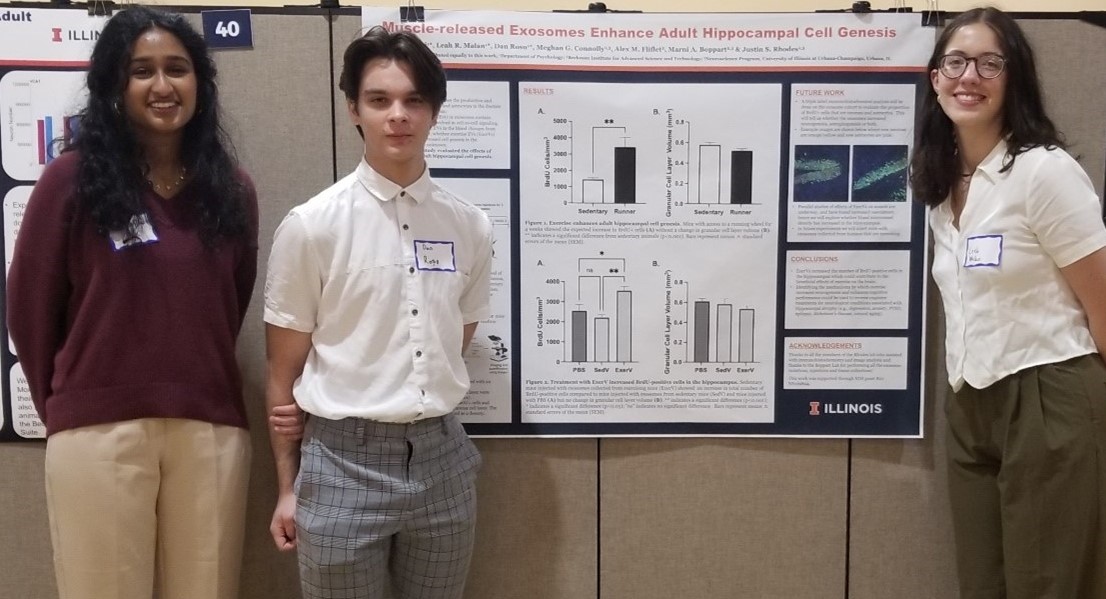
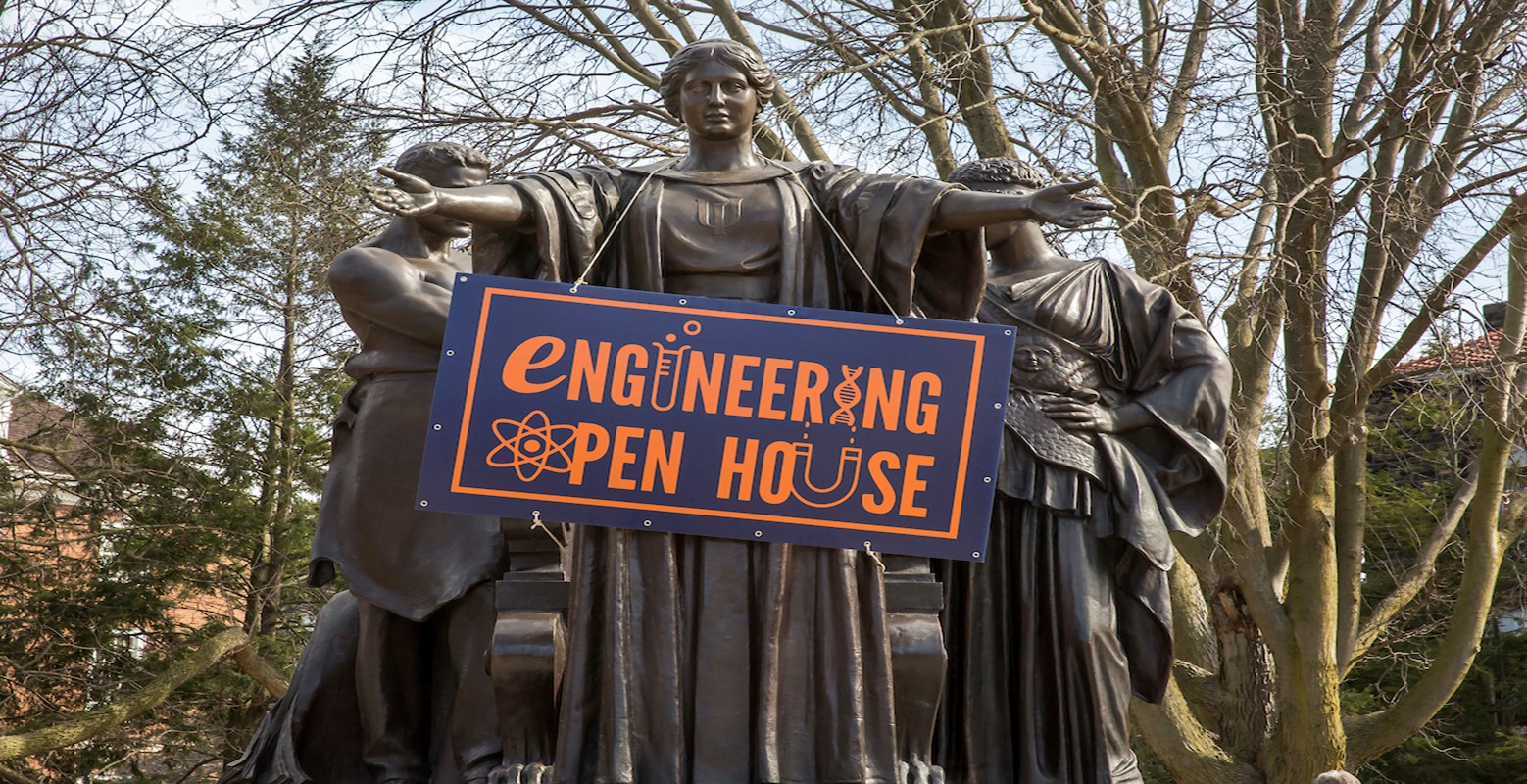
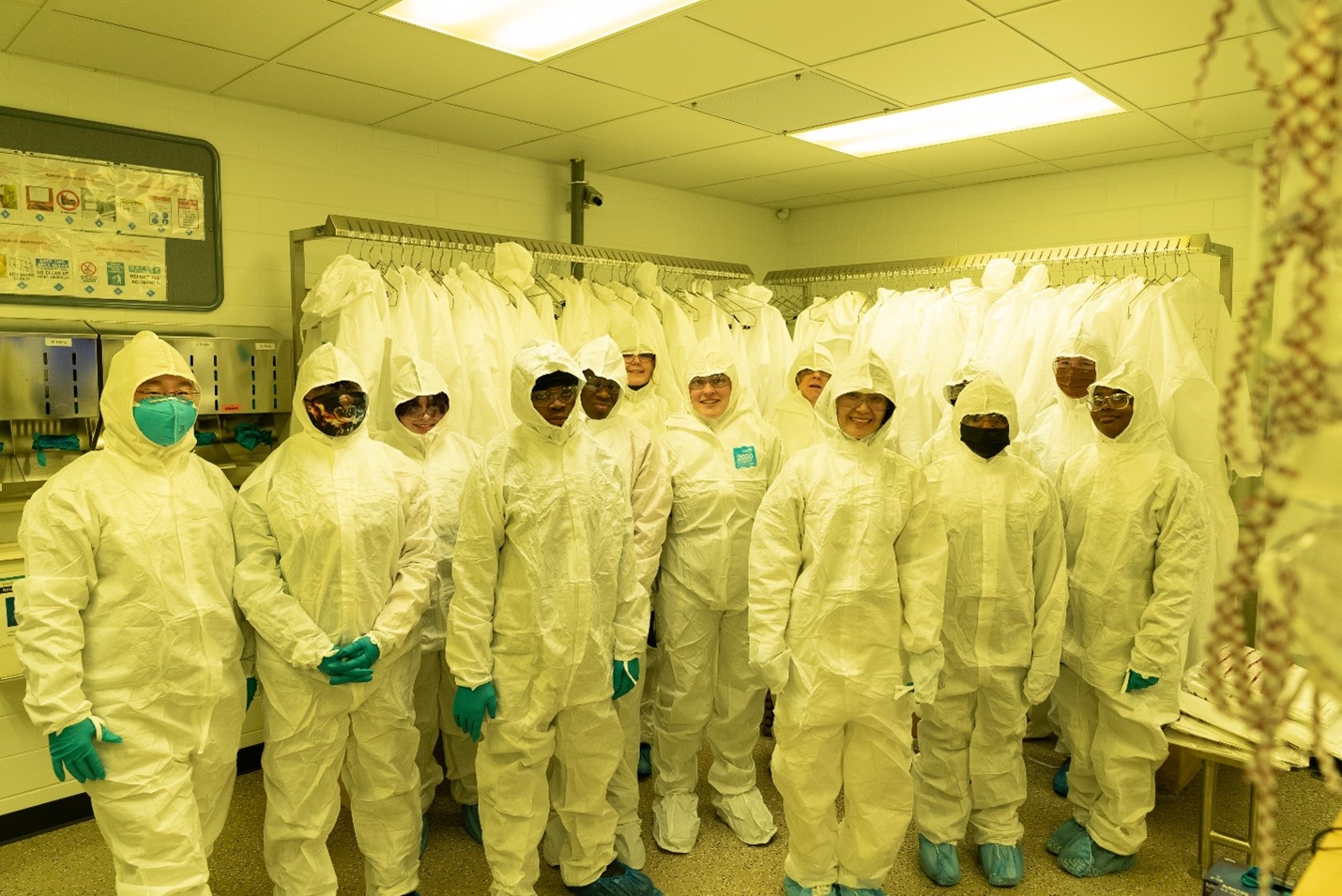
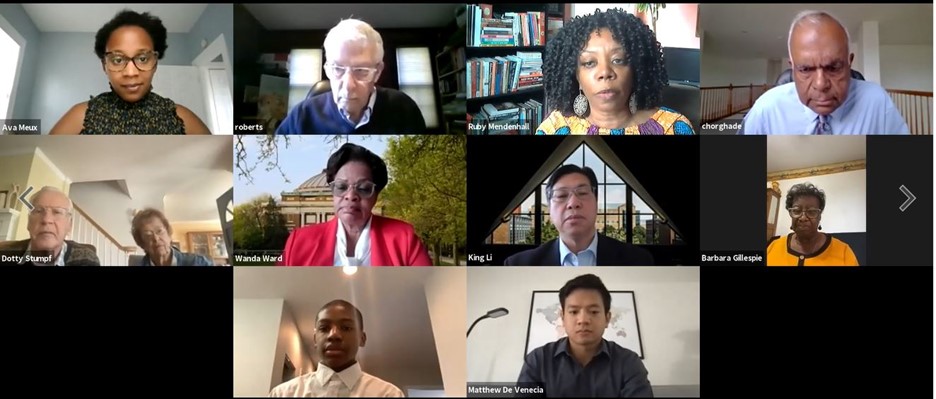
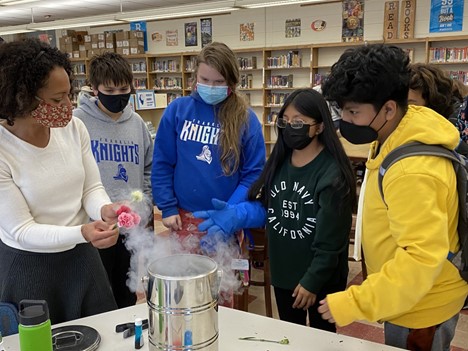
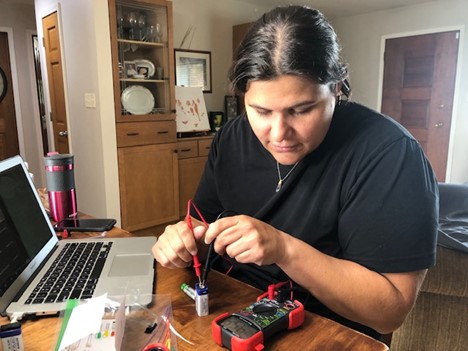
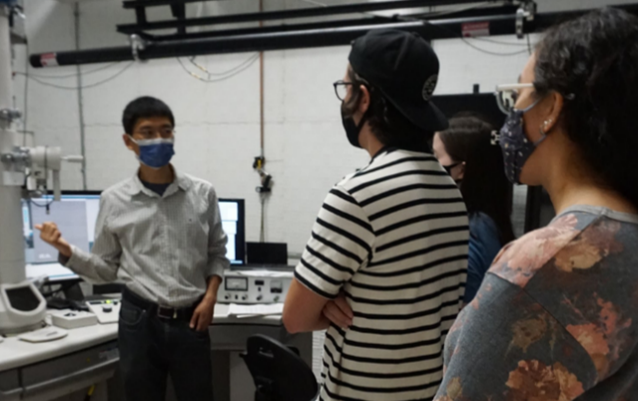
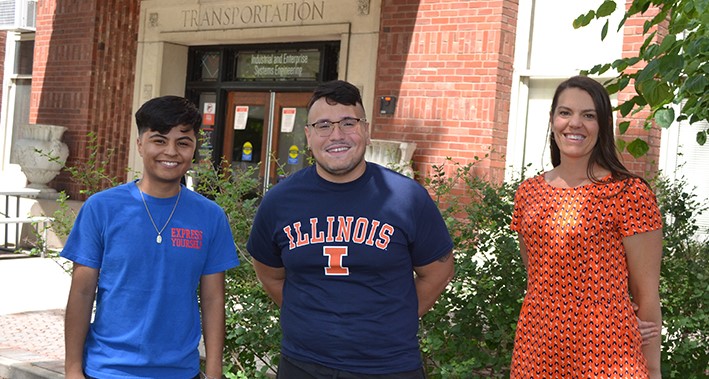


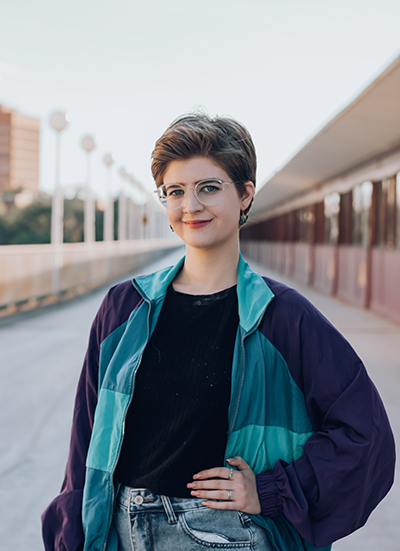
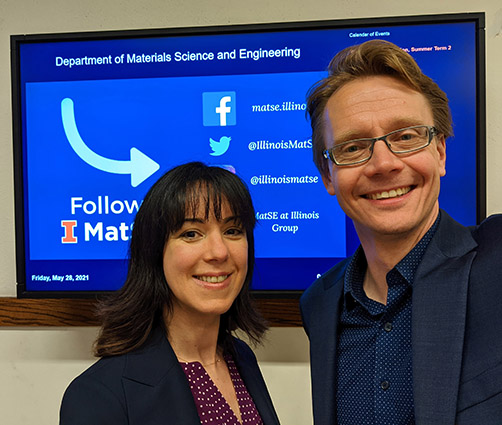
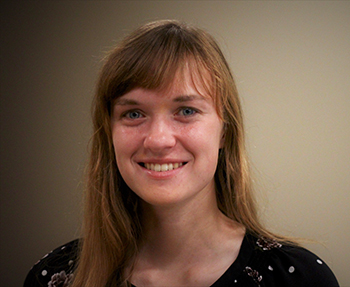
.jpg)
